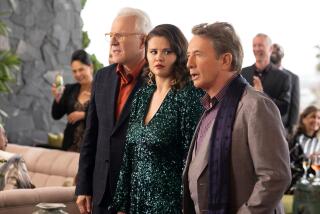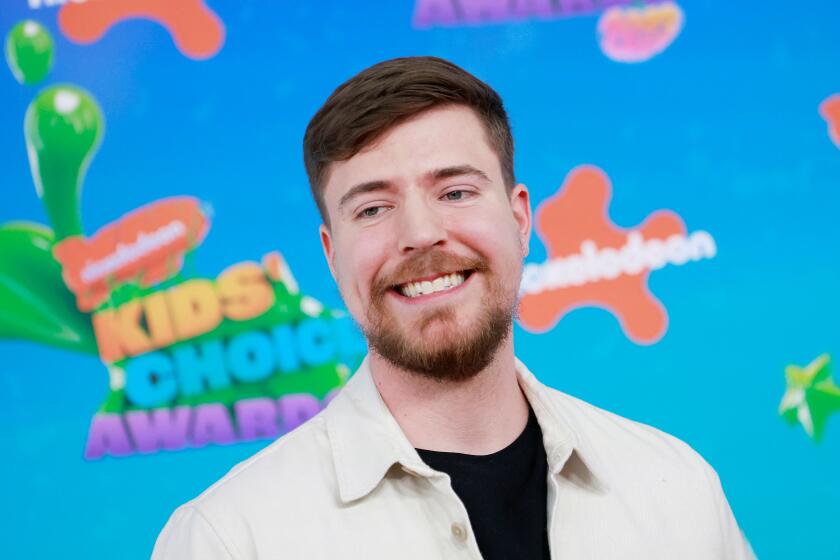Netflix tries to build on in-house brand with ‘Hemlock Grove’
— The fireflies in this coastal Ontario town had begun to materialize over the estate’s sprawling lawn. Inside a macabre-looking residence, the actors Famke Janssen and Bill Skarsgard slipped through elegant rooms and chilly corridors, a bone-creepy tableau that might be described as “The Addams Family” meets Guillermo del Toro. Her voice musical but no-nonsense, Janssen issued an order to Skarsgard; he responded by trying very hard to look aloof.
The location for the production of “Hemlock Grove” — a piece of small-town American Gothic about a murder, a shady company and rampaging werewolves — was quaint, even archaic.
But if the design was a throwback, the stakes are decidedly modern.
“Hemlock” is a Netflix original series from the horror maestro Eli Roth. On Friday, all 13 episodes, each about 50 minutes, will be made available for streaming — an experiment that will begin to tell whether the Silicon Valley upstart, fresh off the critical success of its Beltway drama “House of Cards,” is a bona fide entertainment power or more of a one-hit wonder.
PHOTOS: Get the look: ‘House of Cards’ star Kate Mara
“It’s a little ironic,” Janssen said in an interview. “This is a show with a very old-world feel, yet it could help create the future of television.”
If it’s to define that future, though, “Hemlock” must overcome several challenges. Netflix is, after all, still relatively new to the original-content business. And the genre spin it is attempting here, a kind of horror-themed “Twin Peaks,” has struggled to find a broad audience even on standard set-top boxes.
Produced by Gaumont International and based on a novel by Brian McGreevy, who serves as a writer and executive producer, “Hemlock Grove” follows the goings-on in a Pennsylvania steel town that has long been dominated by an enigmatic old-money family known as the Godfreys. There’s Roman (Skarsgard), his mother, Olivia (Janssen), Roman’s uncle Norman (Dougray Scott) and Roman’s ghoulish sister Shelley (Nicole Boivin); they control a mysterious biotech company, among other things.
Into this mix drops a newcomer, Peter Rumancek (Landon Liboiron), a wanderer who with his mom (Lili Taylor) moves into a trailer in a shabby part of town, setting tongues wagging with whispers of beastly powers. Matters get even more hairy when the attractive teenager Brooke Bluebell is brutally murdered, putting the town and its two-bit police department on edge.
The show practices a narrative sleight-of-hand — as Bluebell says not long before she turns up dead, “There’s just so much more happening than what you see” — as it moves between clues and genres. (Roman, for instance, may be a vampire.)
But for all the bloodsuckers and moon-bayers, creators say they’re aiming for something more human.
PHOTOS: Celebrities by The Times
“One of the central ideas I had was to look at community and what it means to be an outsider,” McGreevy said. “Beneath all the tropes, I wanted to explore what it was like not to belong.” He said he created “Hemlock” as an antidote of sorts to “Twilight.” “I’m not sure when the vampire mythology became about marrying someone barefoot on a beach in Hawaii,” he quipped.
Roth was similarly compelled. Despite his pedigree as the so-called godfather of torture porn, the “Hostel” director wants “Hemlock” to aim for nuance.
“This is in the horror universe. But you’re not watching a terrifying story,” he said, rattling off comparisons to “Twin Peaks” and “The X-Files.” “It’s about an unfolding mystery and the larger forces at play. I see it as a soap opera of a small town.”
(He acknowledged he did want to put some more graphic scenes into the first episode of “Hemlock,” which he directed, but Netflix nixed them because they were “too strong.”)
The company, which already has development chips on a variety of genres, sees “Hemlock” as a chance to shore up a fan base. AMC zombie series “The Walking Dead” racks up huge numbers (in part through a deal with Netflix, coincidentally). Horror films, executives believe, are already weatherproof at a stormy box office. Why not offer the genre digitally, only this time 10 or 12 hours at a clip instead of 90 minutes every year or two?
“Look at ‘Evil Dead,’ both the original and the new one,” said Netflix chief content officer Ted Sarandos. “There’s a hard-core audience for this that we think we can target.”
Reminded that devotion doesn’t always mean broad popularity, he said that “Hemlock” involved a “proportionately lower investment” than “Cards,” allowing for it to draw a smaller audience and still be financially viable. (The company will not release audience totals for “House of Cards.”)
For creators, Netflix’s involvement offers a few advantages. On set, McGreevy and his collaborator Lee Shipman talk about a creative freedom beyond studios or even cable networks.
And shooting in one lump amount allows for creators to avoid many of TV’s built-in problems, including the need for artificial stops before commercials and at each episode’s end, as well as the ability to circumvent the limits of special effects. Without the rigid constraints of an eight-day shoot (standard for TV shows), “Hemlock,” Roth noted, was able to scatter pieces of production for an elaborate werewolf set piece throughout the shoot.
Still, it isn’t simple for Netflix to release a new show. Without the benefits of lead-ins and in-network promos, the company has to rely on marketing and word of mouth. A program has to work that much harder to gain viewers.
And the Netflix seal of approval — in addition to “House of Cards” the company also has the highly anticipated “Arrested Development” returning next month — actually could work against it. Already “Hemlock” reviewers, who have not been kind, have begun to make the comparison to other Netflix shows. “Here comes the company’s first truly bad series,” wrote the Hollywood Reporter in a scathing review that said the program “barely makes sense.”
Sarandos plays down the early critical response. “This show’s not made for critics — it’s made for viewers,” he said.
Creators, meanwhile, say they’re making this show with not only populist aims but demographic ones.
“I want high school and college students to watch this,” said Roth, noting that people first exposed to “Twilight” in grade school were ready for something harder-edged. “I want people to be freaked out, like in a sex-ed class where you show a video of a childbirth, and the whole class is screaming and laughing.” He added: “And because it’s Netflix, I want people to rewind and watch it again.”
PHOTOS, VIDEOS & MORE:
Real places, fake characters: TV’s bars and eateries
PHOTOS: ‘The Ellen DeGeneres Show’ through the years
PHOTOS: Violence in TV shows
More to Read
The complete guide to home viewing
Get Screen Gab for everything about the TV shows and streaming movies everyone’s talking about.
You may occasionally receive promotional content from the Los Angeles Times.







